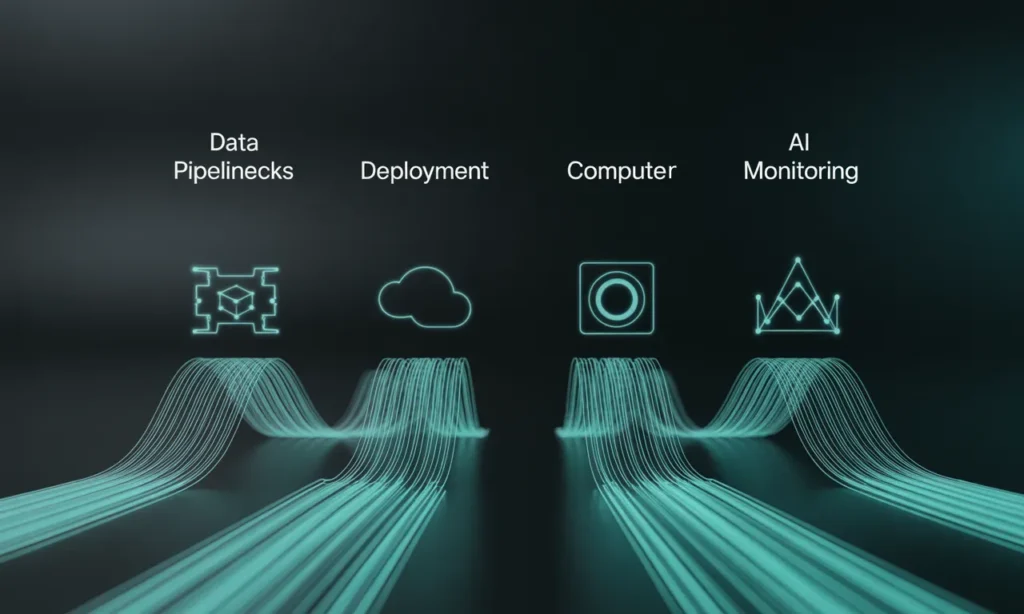As artificial intelligence transitions from experiments to essential business systems, CTOs and Engineering Managers face a growing challenge: designing infrastructure that scales seamlessly with expanding data, increasing model complexity, and evolving workloads.
Getting the infrastructure right isn’t just a technical milestone, it’s a strategic one. Gartner reports that 85% of AI projects fail due to inadequate infrastructure, while companies with mature systems experience 3–5× faster time-to-value.
Scalable AI infrastructure is now a business imperative, driving performance, cost efficiency, and innovation velocity.
The Four Most Common AI Infrastructure Bottlenecks

Many organizations discover that what worked during a prototype phase begins to collapse under production demands. Common scaling bottlenecks include:
- Data Pipelines – Fragile or ad-hoc systems struggle with schema changes and data drift.
- Deployment – Manual or non-standard deployment practices delay production cycles.
- Compute – Monolithic systems and under-provisioned GPUs limit throughput.
- Monitoring – Lack of drift detection and observability causes silent model degradation.
Each of these issues compounds over time, leading to downtime, inflated costs, and lost trust in AI-driven insights.
Build vs. Buy: Making the Right Choice for AI Infrastructure

One of the most strategic questions for technical leaders is whether to build or buy each component of their AI stack.
| Component | When to Build | When to Buy |
|---|---|---|
| Data Pipelines | Custom data transformations and domain logic | For standardized ETL/ELT workflows |
| Training Platforms | When tuning and control are critical | When scalability and reliability matter most |
| Feature Stores | For unique, domain-specific requirements | For generic feature reuse and consistency |
| MLOps Tools | For compliance-heavy environments | For automation and monitoring readiness |
Best Practice: Many successful AI organizations use a hybrid approach, building components that offer strategic differentiation while buying proven tools for operational efficiency.
Proven Patterns for Scaling AI Infrastructure
Modern AI infrastructure relies on architectural patterns designed for flexibility, modularity, and growth. Some of the most effective include:
- Microservices Architecture – Decouple workloads for independent scaling and deployment.
- Data Lakehouse Pattern – Combine flexibility of data lakes with structure of warehouses.
- Hybrid Cloud Deployments – Leverage both cloud elasticity and on-premise compliance.
- Model Versioning – Maintain rollback-ready registries and CI/CD for ML models.
These designs reduce the risk of technical debt, simplify observability, and future-proof infrastructure against rapid AI evolution.
A Phased Roadmap: From Prototype to Production

Scaling AI should follow a deliberate, phased roadmap. This ensures each layer, data, model, and deployment, matures systematically.
Phase 1: Prototype (0–6 Months)
Establish validated data pipelines, track experiments, and version models using managed tools.
Phase 2: Production Hardening (6–18 Months)
Implement CI/CD, introduce feature stores, and expand monitoring to include data drift detection.
Phase 3: Enterprise Scale (18–36 Months)
Automate retraining, integrate multi-model orchestration, and adopt advanced observability systems.
Phase 4: Optimization (36+ Months)
Adopt edge AI, global deployments, and hardware acceleration for performance at scale.
Example: A healthcare startup transitioned from prototype to production in under 12 months by modularizing pipelines, implementing automated retraining, and optimizing compute allocation, achieving 4× faster deployments and 30% lower costs.
How AI Development Services Enable Scalable Infrastructure
Building scalable AI systems isn’t just about technology, it’s about intelligent design that bridges experimentation and production.
A dedicated AI Development Service helps organizations streamline this process by:
- Architecting scalable and modular AI workflows tailored to business needs.
- Designing automated retraining and deployment pipelines for faster iteration.
- Integrating real-time monitoring and observability for proactive issue detection.
- Aligning data, model, and infrastructure strategy under a unified lifecycle approach.
These services bridge the gap between data engineering, model operations, and DevOps, ensuring that AI systems grow with the organization rather than becoming bottlenecks.
Measuring What Matters: Key Infrastructure Metrics
Scalability without metrics is directionless. The most effective AI teams track measurable outcomes across performance, reliability, and efficiency:
| Category | KPI | Target |
|---|---|---|
| Performance | P95 Inference Latency | < 50ms |
| Productivity | Model Deployment Cycle | < 14 Days |
| Reliability | Reproducibility Rate | > 90% |
| Efficiency | Cost per 1M Predictions | ↓ 30–50% YoY |
Regularly tracking these metrics provides visibility into the maturity and impact of AI infrastructure, ensuring continuous improvement.
The Long-Term Advantage of Strategic Infrastructure
Investing in AI infrastructure is more than a cost decision, it’s an innovation multiplier. Robust systems not only reduce downtime and improve performance but also unlock the agility to explore new opportunities like generative AI, real-time analytics, and personalized applications.
Organizations that treat infrastructure as a strategic asset see faster innovation cycles, lower costs per model, and stronger data governance, all essential for long-term AI competitiveness.
Conclusion: Building for the AI-Driven Future
The future of business innovation depends on scalable, reliable, and intelligent AI infrastructure.
Every phase of the AI journey, from prototype to production, requires careful alignment between architecture, automation, and monitoring. By investing in systems that are flexible and future-ready, companies create a foundation that not only supports today’s AI workloads but accelerates tomorrow’s breakthroughs.
If your organization is ready to move beyond experimentation and scale with confidence, consider leveraging a specialized AI Development Service to build the infrastructure that powers lasting AI success.






